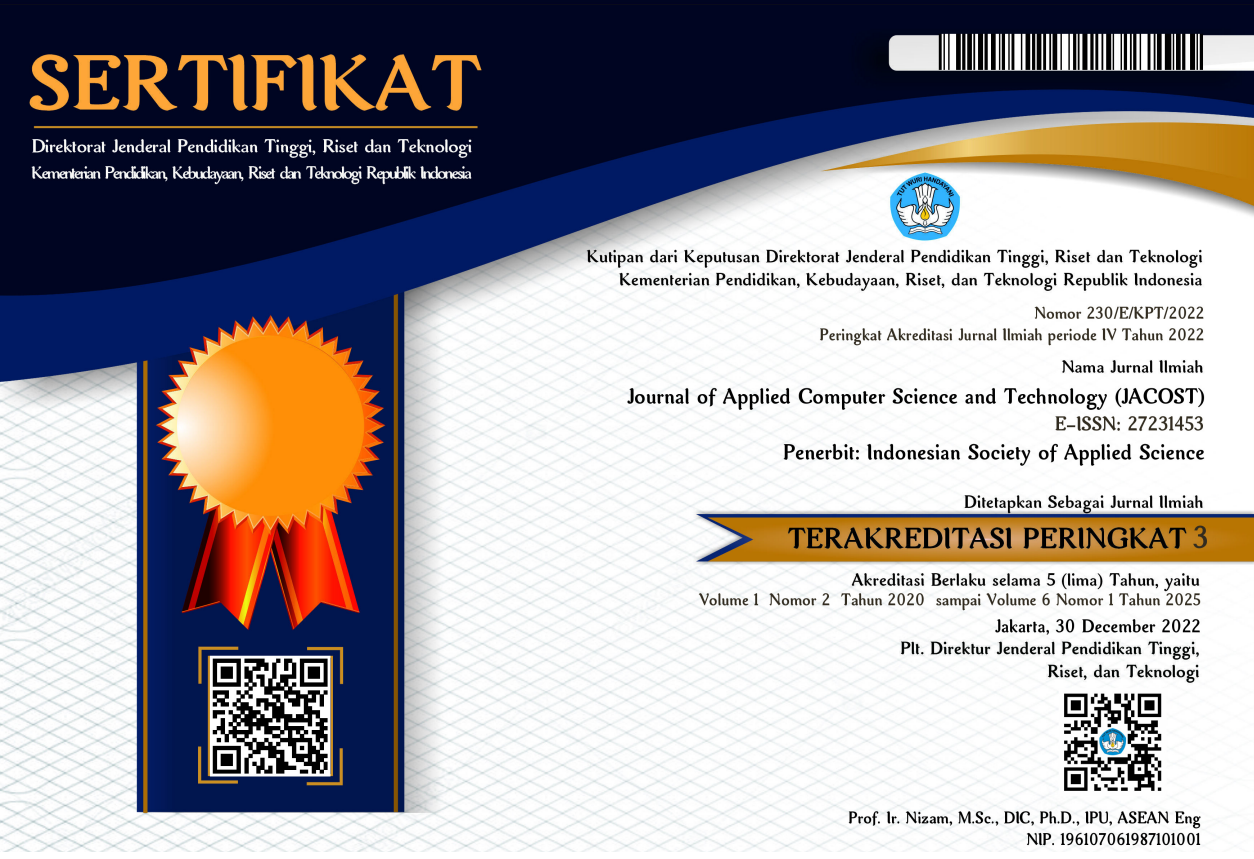Analisis Trafik Pengguna XL Axiata Jakarta Selama Pandemi Covid-19 dengan Menggunakan Metode Regresi Linier
DOI:
https://doi.org/10.52158/jacost.v2i1.158Keywords:
Covid-19, XL Axiata, Linear Regression, User Traffic, Data MiningAbstract
2020 is a very disturbing year for the whole world because in 2020 there is a deadly virus, the virus is called Covid-19. The Indonesian government has a strategy to deal with the Covid-19 virus, namely by implementing Large-Scale Social Restrictions (PSBB). Where the implementation of this PSBB requires residents to do more activities at home. To carry out activities at home, internet access is needed. Therefore, providers are the companies that benefit the most, providers are companies that provide internet services, one of which is XL Axiata. During the Covid-19 pandemic, XL Axiata company wants to conduct analysis for XL Axiata in the next year, whether the traffic of XL Axiata users has increased or decreased and how many devices need to be upgraded or safe. In conducting this analysis, it is necessary to perform fast data processing, data processing using the Data Mining method with Linear Regression techniques. The data to be processed will be obtained from the XL Axiata company, namely XL Axiata traffic data. By processing data using Linear Regression results in future predictions, the West Jakarta Municipality has increased per week by an average of 0.12%, the East Jakarta Municipality has decreased per week by an average of 0.27%, the Central Jakarta Municipality experiences the decline per week by an average of 2.31%, the South Jakarta Municipality experienced an increase per week by an average of 1.17%, and in the North Jakarta Municipality it decreased per week by an average of 0.12%.
Downloads
References
Harani, N. H., & Hasana, M. (2020). Deteksi Objek dan Pengenalan Karakter Plat Nomor Kendaraan Indonesia Berbasis Python. Bandung: Kreatif Industri Nusantara.
Kastanja, A. J., & Tupalessy, J. (2017). Peramalan Beban Listrik Kota Ambon Tahun 2016-2022. Jurnal Simetrik, 41-46.
Ketamba, P., & Djoh, R. K. (2017). Prediksi Tingkat Produksi Kopi Menggunakan Regresi Linear. Jurnal Ilmiah FLASH, 42-51.
Kurniawan, H., Defit, S., & Sumijan. (2020). Data Mining Menggunakan Metode K-Means Clustering Untuk Menentukan Besaran Uang Kuliah Tunggal. Journal Of Applied Computer Science And Technology (JACOST), 80-89.
Maharani, M., Bobanto, M. D., & Ferdy. (2017). Hubungan Cuaca dan Tanaman Pangan Menggunakan Regresi Linear di Kota Tondano. Jurnal Matematika dan Aplikasi, 169-175.
Mueller, Paul, J., Massaron, & Luca. (2019). Python for Data Science For Dummies. Canada: John Wiley & Sons.
Septyawan, R. (2018). Analisis Peramalan Kebutuhan Energi Listrik PLN Area Batam Menggunakan Metode Regresi Linear. Yogyakarta: Universitas Islam Indonesia.
Sofyan, H. (2016). Analisis Kritis atas Laporan Keuangan. Jakarta: Rajawali Pers.
Suyono. (2018). Analisis Regresi untuk Penelitian. Yogyakarta: Deepublish.
Yanto, R. (2018). Implementasi Data Mining Estimasi Ketersediaan Lahan Pembuangan Sampah menggunakan Algoritma Regresi Linear. Jurnal RESTI (Rekayasa Sistem dan Teknologi Informasi), 361-366.
Downloads
Published
Issue
Section
License
Pernyataan Hak Cipta dan Lisensi
Dengan mengirimkan manuskrip ke Journal of Applied Computer Science and Technology (JACOST), penulis setuju dengan kebijakan ini. Tidak diperlukan persetujuan dokumen khusus.
- Hak cipta pada setiap artikel adalah milik penulis.
- Penulis mempertahankan semua hak mereka atas karya yang diterbitkan, tak terbatas pada hak-hak yang diatur dalam laman ini.
- Penulis mengakui bahwa Journal of Applied Computer Science and Technology (JACOST) sebagai yang pertama kali mempublikasikan dengan lisensi Creative Commons Atribusi 4.0 Internasional (CC BY-SA).
- Penulis dapat memasukan tulisan secara terpisah, mengatur distribusi non-ekskulif dari naskah yang telah terbit di jurnal ini kedalam versi yang lain (misal: dikirim ke respository institusi penulis, publikasi kedalam buku, dll), dengan mengakui bahwa naskah telah terbit pertama kali pada Journal of Applied Computer Science and Technology (JACOST);
- Penulis menjamin bahwa artikel asli, ditulis oleh penulis yang disebutkan, belum pernah dipublikasikan sebelumnya, tidak mengandung pernyataan yang melanggar hukum, tidak melanggar hak orang lain, tunduk pada hak cipta yang secara eksklusif dipegang oleh penulis.
- Jika artikel dipersiapkan bersama oleh lebih dari satu penulis, setiap penulis yang mengirimkan naskah menjamin bahwa dia telah diberi wewenang oleh semua penulis bersama untuk menyetujui hak cipta dan pemberitahuan lisensi (perjanjian) atas nama mereka, dan setuju untuk memberi tahu rekan penulis persyaratan kebijakan ini. Journal of Applied Computer Science and Technology (JACOST) tidak akan dimintai pertanggungjawaban atas apa pun yang mungkin timbul karena perselisihan internal penulis.
Lisensi :
Journal of Applied Computer Science and Technology (JACOST) diterbitkan berdasarkan ketentuan Lisensi Creative Commons Atribusi 4.0 Internasional (CC BY-SA). Lisensi ini mengizinkan setiap orang untuk :.
- Berbagi — menyalin dan menyebarluaskan kembali materi ini dalam bentuk atau format apapun;
- Adaptasi — menggubah, mengubah, dan membuat turunan dari materi ini untuk kepentingan apapun.
Lisensi :
-
Atribusi — Anda harus mencantumkan nama yang sesuai, mencantumkan tautan terhadap lisensi, dan menyatakan bahwa telah ada perubahan yang dilakukan. Anda dapat melakukan hal ini dengan cara yang sesuai, namun tidak mengisyaratkan bahwa pemberi lisensi mendukung Anda atau penggunaan Anda.
-
BerbagiSerupa — Apabila Anda menggubah, mengubah, atau membuat turunan dari materi ini, Anda harus menyebarluaskan kontribusi Anda di bawah lisensi yang sama dengan materi asli.

















